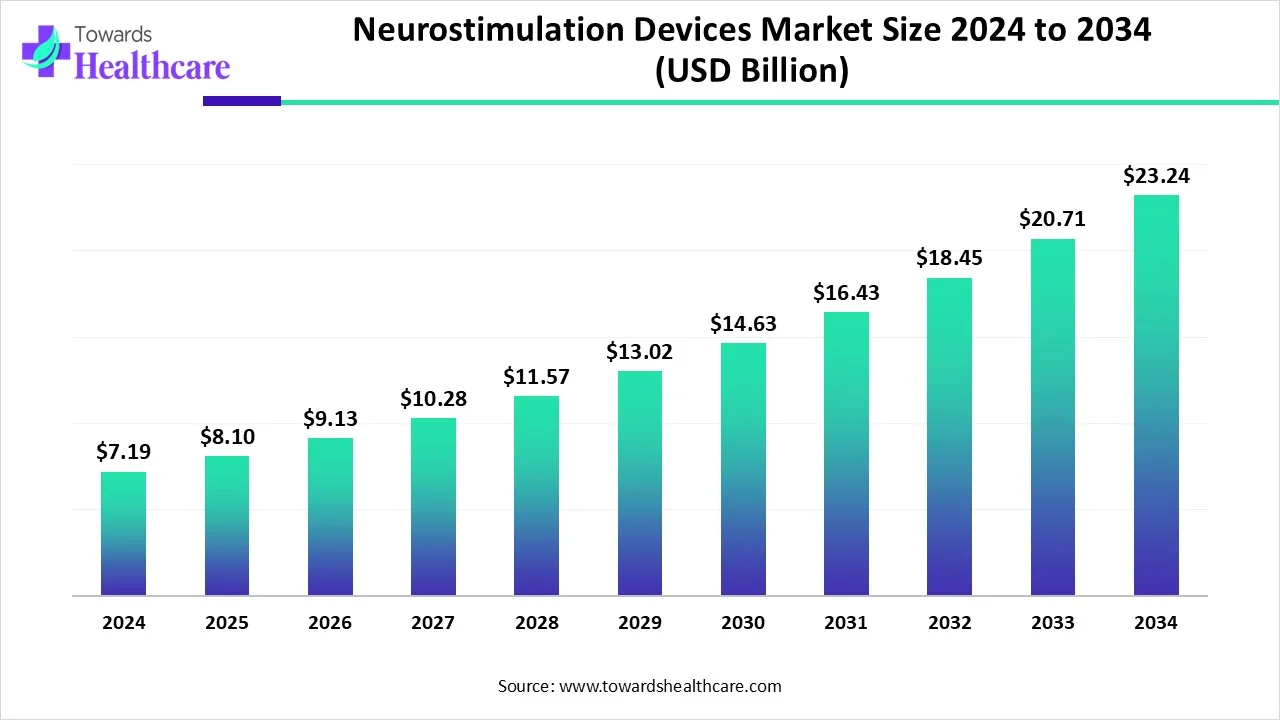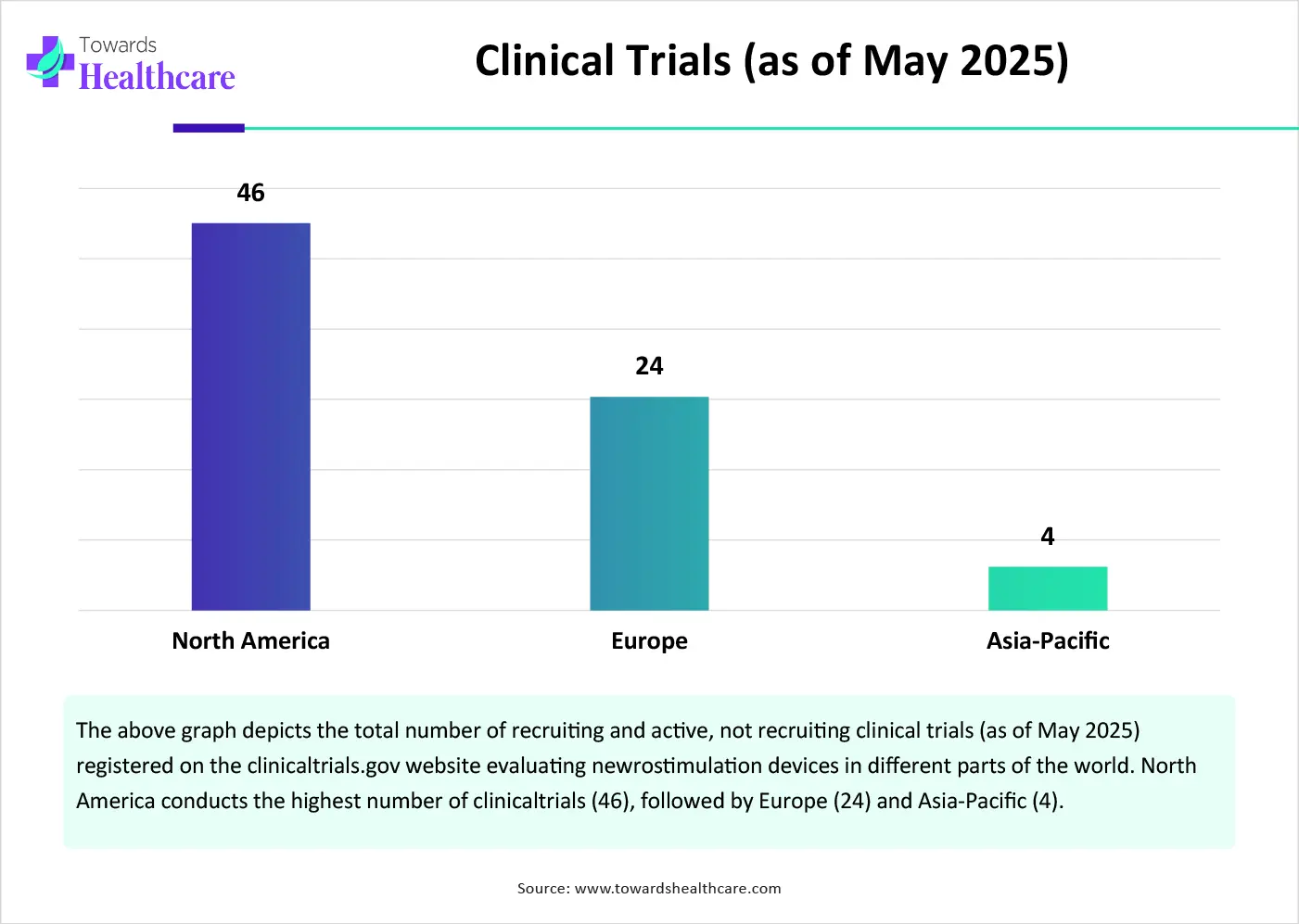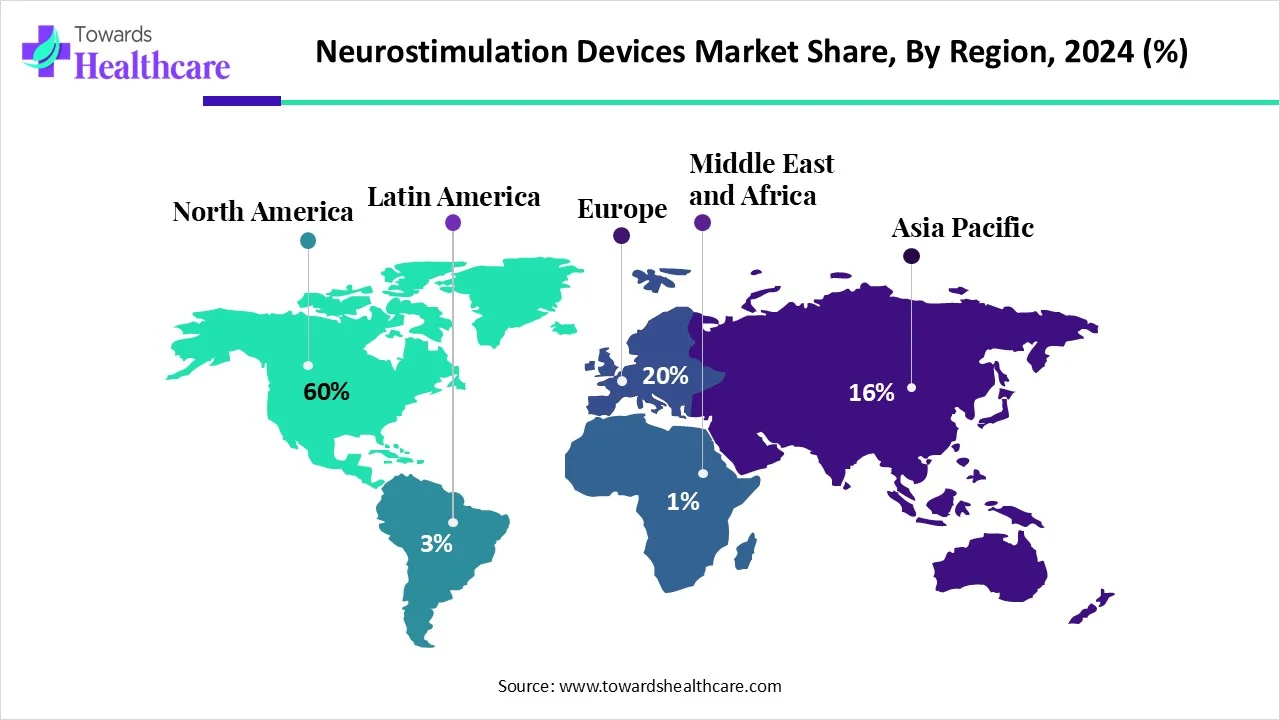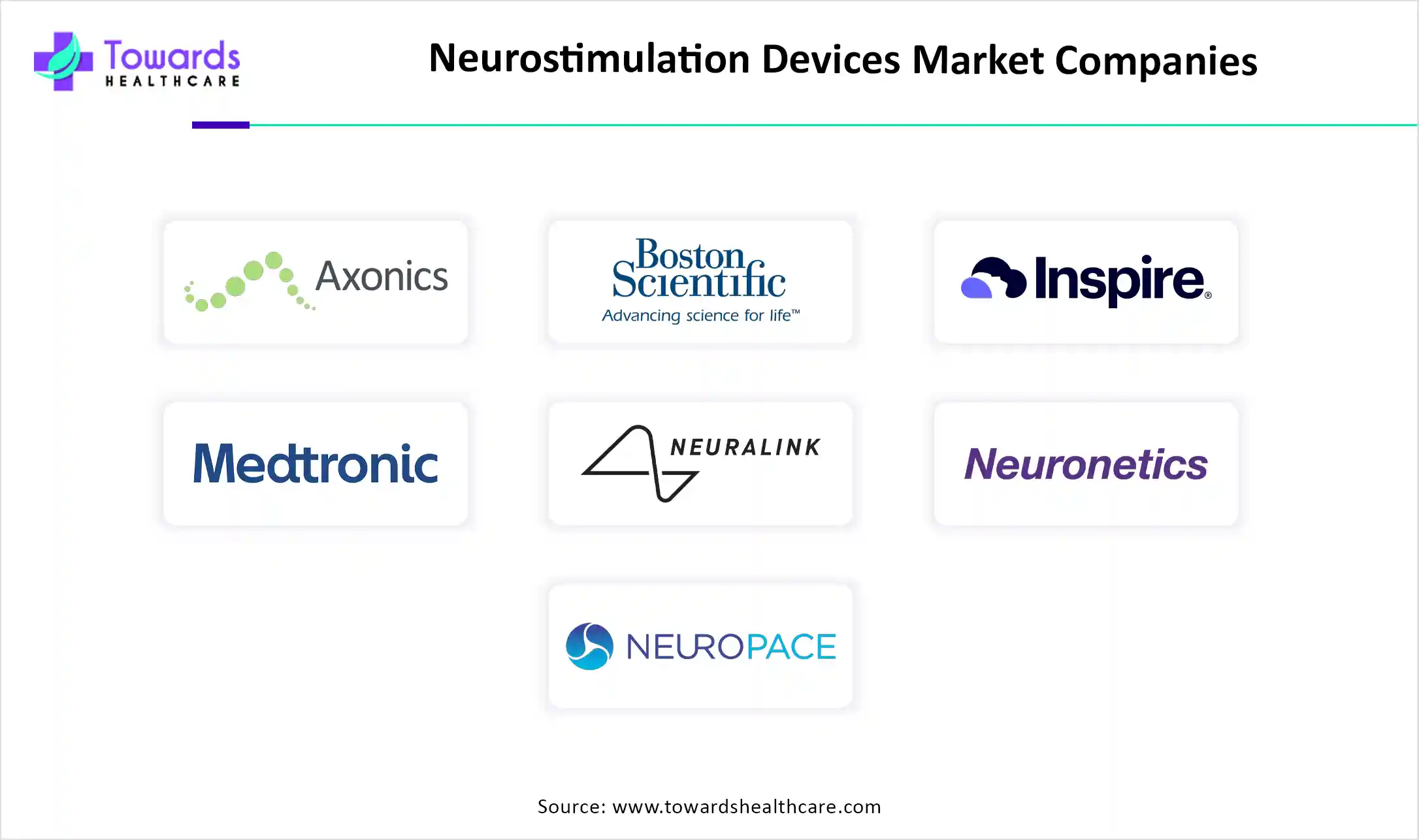December 2025

The global neurostimulation devices market size is calculated at USD 7.19 billion in 2024, grew to USD 8.1 billion in 2025, and is projected to reach around USD 23.24 billion by 2034. The market is expanding at a CAGR of 12.84% between 2025 and 2034.

| Metric | Details |
| Market Size in 2025 | USD 8.1 Billion |
| Projected Market Size in 2034 | USD 23.24 Billion |
| CAGR (2025 - 2034) | 12.84% |
| Leading Region | North America |
| Market Segmentation | By Product, By Application, By Region |
| Top Key Players | Axonics Modulation Technologies, Boston Scientific, Inspire Medical Systems, Inc., Medtronic, Neuralink, Neuronetics, NeuroPace, Nevro Corp, Nexalin Technology, Nuvectra Corporation, Soterix Medical, Inc., SPR Therapeutics, Inc. |
Neurostimulation is a technique that involves using electrical impulses to stimulate specific nerves or regions in the body responsible for sending pain signals. Neurostimulation devices are primarily used for treating chronic pain, movement disorders, and other neurological diseases, such as neuropathic pain, failed back surgery syndrome, Parkinson’s movement symptoms, and epilepsy. These devices offer both invasive and noninvasive approaches to apply electrical stimulation. The different types of neurostimulation devices and treatments include spinal cord stimulation, deep brain stimulation, vagus nerve stimulation, and peripheral nerve stimulation.
Several factors influence the market, including the rising prevalence of neuromuscular disorders & chronic pain and the rapidly expanding medical device sector. The growing research and development activities lead to the development of novel and innovative neurostimulation devices. This also facilitates the increasing number of clinical trials. Technological advancements improve the functionality of neurostimulation devices. Favorable government policies and regulatory frameworks support the development and launch of these devices, fostering market growth.

Artificial intelligence (AI) can transform neurostimulation devices through automation, enhancing efficiency. AI and machine learning (ML) algorithms can analyze vast amounts of patient data and offer personalized treatment. AI-driven devices can operate and respond accordingly based on patients’ behaviors and needs. They can deliver targeted therapy for pain relief in specific conditions. Integrating AI and ML into neurostimulation devices enables real-time data analysis, providing healthcare professionals with unprecedented insights into neural activities and patterns. AI can also restore lost sensory or motor functions, offering renewed independence to patients with disabilities.
Rising Prevalence of Chronic Pain
The rising prevalence of chronic pain among individuals increases the demand for neurostimulation devices. The growing geriatric population is a major reason for chronic pain. A recent study from the National Institute of Health reported that the incidence of chronic pain is around 52.4 new cases per 1,000 people annually in the U.S., a higher rate compared to other common health conditions, including diabetes, depression, and high blood pressure. According to a recent systematic review and meta-analysis study, the global prevalence of peripheral diabetic neuropathy was 46.7% as of June 2024. Chronic pain can impair an individual’s quality of life, leading to physical limitations, emotional distress, and social isolation.
Lack of Trained Professionals
The major challenge of the neurostimulation devices market is the lack of trained professionals. Numerous developing and undeveloped countries do not have sufficient skilled professionals to provide neurostimulation treatment. This potentiates the risk of using the incorrect settings or intensity levels, leading to muscle strain, discomfort, or potential injury.
Brain-Computer Interface (BCI)
The future of the market is promising, driven by the development of the brain-computer interface (BCI). BCI is a device that enables a person to use their brain signals to control an external device. It captures and analyzes brain signals, then translates them into usable commands for an external device to put into action. It is used to restore movement and autonomy in patients with paralysis and disabilities. It also facilitates computer-augmented communication through the eye movement of patients who are unable to speak. BCI is also proven to treat neurological conditions, such as ALS, cerebral palsy, brainstem stroke, and spinal cord injuries. It can monitor mental health and enhance cognitive functioning in real time.
For instance,
By product, the spinal cord stimulator segment held a dominant presence in the market in 2024. A spinal cord stimulator consists of electrodes and a generator to send electrical impulses using an external control. The rising prevalence of spinal cord injury and post-surgical pain boosts the segment’s growth. The World Health Organization (WHO) reported that globally, more than 15 million people are living with spinal cord injury. (Source - WHO)
The major causes of SCIs are trauma, including falls or road accidents. The growing demand for personalized treatment also augments the segment’s growth, as it allows personalized adjustments based on patients’ pain patterns.
By product, the sacral nerve stimulators segment is expected to expand rapidly in the market in the coming years. Sacral neuromodulation is a well-established, minimally invasive, safe, and effective advanced treatment for a number of bowel and lower urinary tract dysfunctions, including incontinence, urgency, frequency, and retention of urine and feces. Sacral neuromodulation specifically helps those who have not responded to conservative treatments. A neurostimulator is implanted to successfully modify neural circuits and restore bladder and bowel function by sending electrical impulses to the sacral nerves.
By application, the pain management segment led the global market in 2024. The rising prevalence of chronic pain and post-surgical pain promotes the segment’s growth. A recent prospective study published in the Surgery in Practice and Science journal studied 219 participants. Out of these, 180 (82.2%) had acute postoperative pain, and about 34.24% had moderate to severe pain. (Source - Science Direct)
By application, the epilepsy segment is expected to grow with the highest CAGR in the market during the studied years. The increasing incidences of epilepsy propel the segment’s growth. The WHO reported that approximately 50 million people are affected by epilepsy globally. It also stated that an estimated 5 million people are diagnosed with epilepsy annually. Many people do not react to epilepsy drugs. Hence, neurostimulation devices are preferred for patients with drug-resistant epilepsy, increasing the chances of care.

North America dominated the global market share by 60% in 2024. The presence of key players and the rising adoption of advanced technologies are the major growth factors of the market in North America. State-of-the-art research and development facilities lead to the development of novel devices with expanded applications. Favorable government support also promotes the use of neurostimulation devices in North America.
Key players, such as Boston Scientific and Nevro Corp, are the major contributors to the market in the U.S. The Food and Drug Administration (FDA) regulates the approval of neurostimulation devices, and the National Institute of Neurological Disorders and Stroke (NINDS) supports research related to neurological disorders. The FY 2025 President’s Budget of NINDS is approximately $2.833 billion. (Source - NIH)
It is estimated that around 8 million Canadians, or approximately 1 in 5 Canadians, suffer from chronic pain. The Canadian government formed the Canadian Pain Task Force (CPTF) to provide advice regarding evidence and best practices for preventing and managing chronic pain. Health Canada recently included the Dolphin Neurostim device in the “List of Medical Devices for Expanded Use”. (Source - Government of Canada)
Asia-Pacific is expected to host the fastest-growing neurostimulation devices market in the coming years. The rising prevalence of neurological disorders and chronic pain drives the market. Several government organizations launch initiatives and create awareness about the screening and early diagnosis of neurological disorders. This demonstrates the significance of neurostimulation devices for personalized care. The growing demand for home healthcare also facilitates the use of neurostimulation devices.
China formed a sweeping action plan for dementia in place by 2030 for its prevention, early diagnosis, treatment, rehabilitation, and care. The plan conducts widespread cognitive function screenings for the elderly and raises awareness and understanding of dementia. (Source - my News) The National Medical Products Administration (NMPA) regulates the approval of neurological devices in China. As of September 2024, the NMPA approved 296 innovative medical devices. (Source - SCIO)
Niti Aayog recently announced plans to form a blueprint on improving the quality of brain health and recognizing early signs of cognitive disorders and dementia. (Source - THE ECONOMICS TIMES) The burgeoning medical device sector and expanding demand for innovative medical devices and therapeutics encourage foreign players to launch their innovative products in India. In November 2024, a 72-year-old patient received Percept RC, a Medtronic product, for the treatment of Parkinson’s disease. (Source - THE ECONOMICS TIMES)
Europe is expected to grow at a considerable CAGR in the neurostimulation devices market in the upcoming period. The rapidly expanding medical device sector and technological advancements propel the market. The increasing healthcare expenditure and favorable government policies boost the market. The rising investments and collaborations favor the development of novel devices. The growing geriatric population is also a major concern in this region.
According to a study published in BMJ, Germany reported the largest increase (38%) in the number of patients with Parkinson’s disease in 2021. It is projected to increase by 27% to 53% by 2050. (Source - The bmj)Germany’s 9% of the revenue is invested in medtech R&D and the patenting of novel technologies, accounting for EUR 3 billion annually. (Source - GTai)
France currently has 1.4 million people with more than 85 years old, and is expected to reach 5 million by 2060. The International Trade Administration (ITA) reported an annual turnover of €37.4 billion in 2023. Moreover, the total exports accounted for €9.56 billion, and the total imports accounted for €13.3 billion. (Source - International Trade Administration)
The Middle East & Africa are expected to grow at a considerable CAGR in the neurostimulation devices market in the upcoming period. The increasing prevalence of neurological disorders and the rapidly expanding medical device sector foster market growth. The rising adoption of advanced technologies and favorable government support contribute to market growth. People are becoming aware of advanced neurostimulation devices. The growing research activities in the neurological field and increasing investments promote the market.
In February 2025, Saudi German Hospital Dubai announced the adoption of the Genio Hypoglossal Nerve Stimulation (HGNS) system for obstructive sleep apnea (OSA). The device revolutionizes OSA treatment in the Middle East and North African (MENA) region, delivering world-class medical care.
Saudi Arabia is positioning itself as a global leader in medical innovation, attracting over $8 billion in investments in 170 transactions. According to a recent cross-sectional study conducted on 343 individuals, 36% individuals had mild neurocognitive disorder, and 31.2% had dementia. Approximately 130,000 people are suffering from Alzheimer’s disease in Saudi Arabia.

In February 2025, Nexalin Technology, Inc. announced positive results of its clinical trials evaluating Deep Intracranial Frequency Stimulation (DIFS) for the reduction of systolic and diastolic blood pressure in patients with major depressive disorder (MDD). Mark White, CEO of Nexalin Technology, Inc., commented that its DFIS technology is important for general and mental health. He believes that the neurostimulation technique is a breakthrough technique and represents the future of mental health treatment. (Source - globenewswire)
By Product
By Application
By Region
December 2025
December 2025
December 2025
December 2025